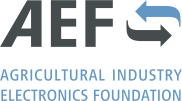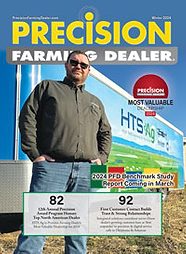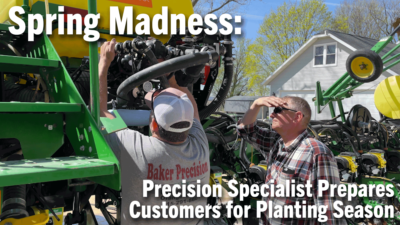M2M, also known as “Machine-to-Machine Communication,” is exactly what it sounds like. It stands for two machines “communicating” together. The term is broadly used to describe the technology that enables network devices to work together.
The Agricultural Industry Electronics Foundation (AEF) is an independent organization funded by international agricultural machinery manufacturers and is very involved in making brand interoperability, through M2M, better for farmers around the world. Today, the AEF consists of 220 ag business-related companies and universities. These groups provide the technical methods and procedures to enable open communication and interfacing between electronic systems of different ag machinery from independent manufacturers.
The AEF is providing the protocols for ag machinery OEM‘s to make safe, precise and smart vehicles that communicate in real-time in the field. The following 3 projects are examples of these efforts.
High Speed ISOBUS
The need for digital camera systems and other high-speed devices around the machines and connected over the hitch has started increasing. While the speed of the current ISOBUS is sufficient for today’s applications, there is a definite need to look to the future to consider what BUS speeds would be required, and so AEF Project Team 10 was formed.
One of their first tasks was to consider the specific use cases; not only the transmission of digital camera signals from around the implement to the display in the tractor cabin, but also the movement of large prescription or diagnostic files. Even advanced control scenarios, such as planters with individual row control sending back numerous bits of information about each row, were considered.
One of the major milestones for this group is the development of a completely new breakaway connector for High Speed ISOBUS. This connector is capable of transmitting real time media/video from around the machine at 1 GB/s. Having agreed on a suitable connector, the project team is now concentrating on defining all the other parts that would contribute to a High Speed ISOBUS. They are planning on demonstrating this technology at the next Agritechnica fair in Hannover, Germany in November 2021.
Wireless In-Field Communication
The target of the AEF Project Team 11 is to allow machines from different manufacturers working in the same field, or on the same operation, to communicate wirelessly. They have chosen an existing radio standard according to requirements like range, data rate, latency and availability that will work in most parts of the world, i.e., including North America and Europe. This will be combined with a communication middleware provider, to enable manufacturers of ag machines to integrate a brand interoperable, machine-to-machine, in-field communication channel. This is similar to a Bluetooth standard for tractors.
So, what will all of this enable? Coverage map sharing between machines of different colors, camera (on one machine) and remote display (on another machine), even platooning (one machine controlling another), will be possible. In addition, this type of communication can be used to communicate to road users (cars and trucks) when there is an ag machine entering the road. This interoperability between machine brands will allow customers to benefit from reduced operator strain and fatigue (e. g. automated procedure for offloading grains to a trailer).
Although the industry has not adopted this technology today, the potential use cases are attractive for the future, and the OEM participation is substantial.
ATLAS
Smart agricultural machines, sensors and data processing services have assisted farmers for years by providing an abundance of information to help optimize farming practices, however, to date, the interoperability of these systems is limited. The aim of the ATLAS project is to realize cross-system data sharing to allow the farmer to get all the available information and services for his or her machine operations all in one place and use it for future farming decisions.
The AEF is one of 30 project partners in this European Union funded project and has set up a dedicated project team to work on the AEF deliverables in ATLAS. As major data generators and data consumers, the machinery manufacturers wanted to ensure that agricultural vehicles can integrate seamlessly into the ATLAS network.
One of the first tasks of the AEF ATLAS team was to develop use cases to make field operations more insight-driven, and potentially more productive and efficient. The following four use cases were defined:
- Machine Tracking: This use case aims to realize the interoperability between machines of different vendors and Farm Management Information Systems (FMIS). In this way, the user can determine the routes the machine can use, determine crop performance and collect up-to-date maintenance records of the machine.
- Online Task Management: This use case aims to reduce time and effort for managing fieldwork by enabling task orders to be planned in the FMIS and exchanged with the machines (of different vendors). Results are also transferred back to the FMIS allowing for real-time documentation of results.
- In-field Sensor Connection: This use case aims to help farmers make informed decisions by providing them overviews of field information. Enabling real-time analysis of data from different in-field sensors and service providers, e.g. weather data, topography of fields, soil condition, is instrumental in precision farming.
- Field Data Management: This use case involves the interoperability of different machines and in-field sensors resulting in providing real-time information on running processes. GIS-related and yield data coming from different systems are examples of so-far fragmented data that will be, in the future, streamlined with utmost accuracy into the FMIS of individual users.
Data exchange between machines and systems used by the farmer has to be easy, protected and automated. And this is the next challenge in the ATLAS project as the team designs the architecture.
About the Author: This article is the seventh in a series of eight by the Agricultural Industry Electronics Foundation (AEF), an independent organization founded on October 28th, 2008 by seven international ag equipment manufacturers and two associations. Today eight manufacturers and three associations are working as core members together with 220 general members. They work to improve cross-manufacturer compatibility of electronic and electric components in agricultural equipment, and to establish transparency about compatibility issues. You can become a member and learn more about the AEF by visiting: www.aef-online.org/home.html or contact the AEF communications team: andrew.olliver@aef-online.org or ryan.milligan@aef-online.org
The Precision Ag - What's under the ISOBUS hood? series is brought to you by the AEF.
The AEF Mission — The development and support for the implementation of generally accepted standards for electric and electronic interfaces as well as standards for data exchange for the agricultural machinery industry. The AEF is providing a framework for the cooperation of all interested parties under the leadership of the core members whilst maintaining competition amongst all members. The AEF supports standardization organizations such as the International Standards Organization (ISO)







Post a comment
Report Abusive Comment